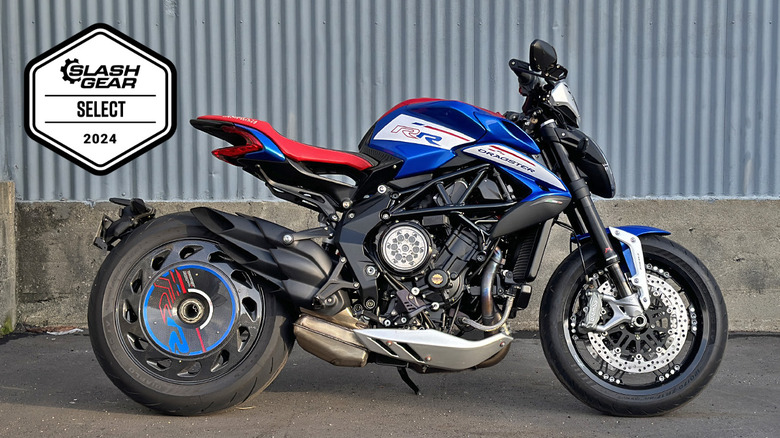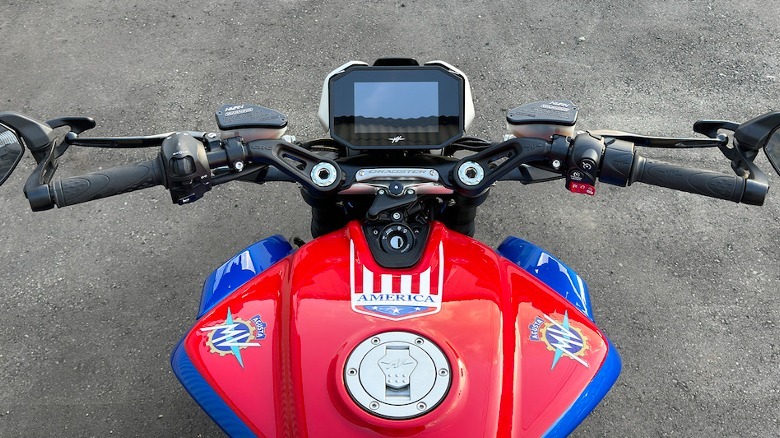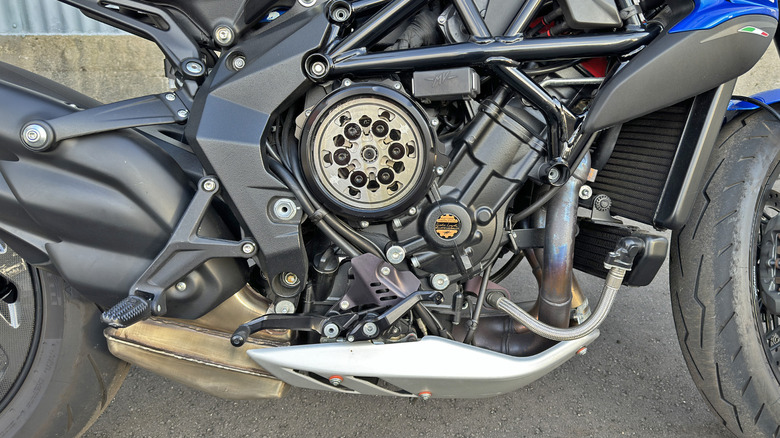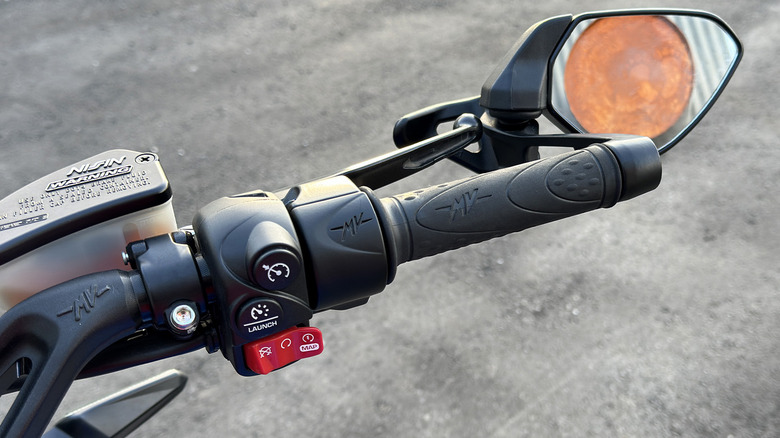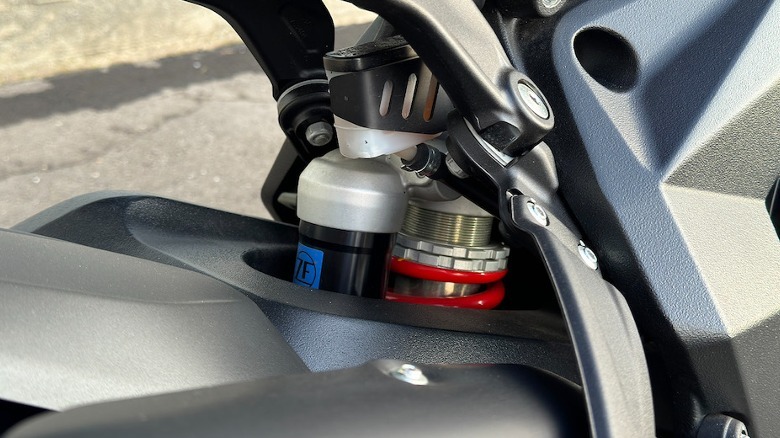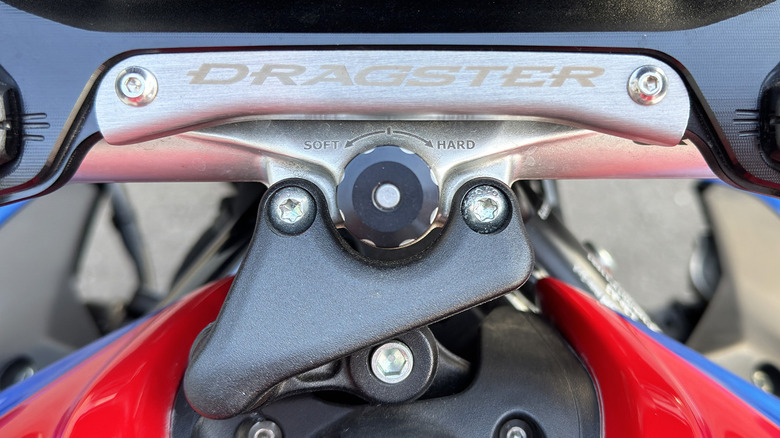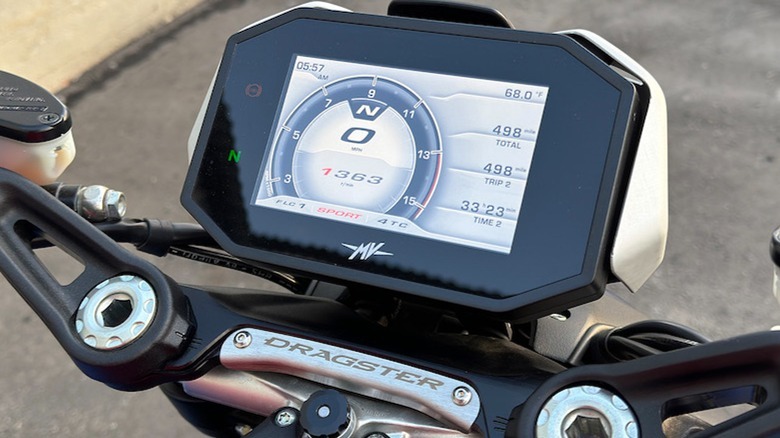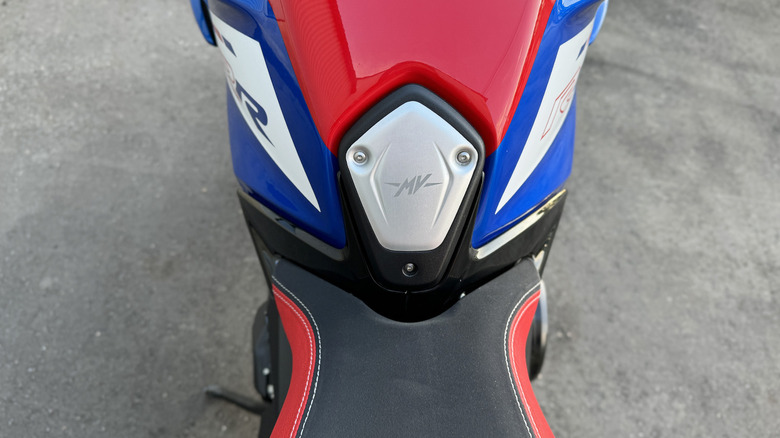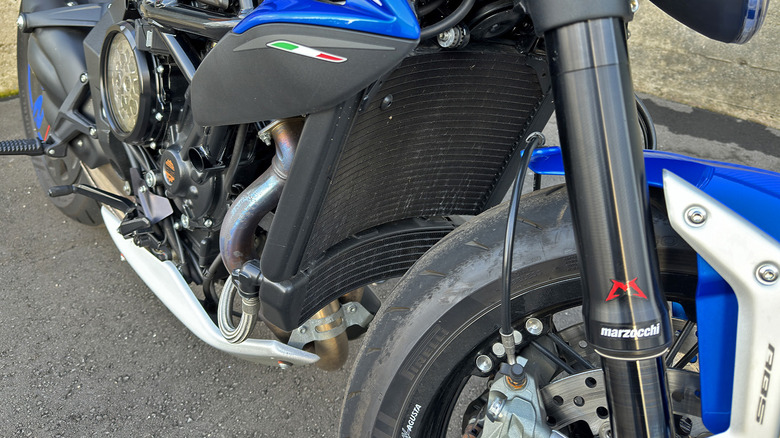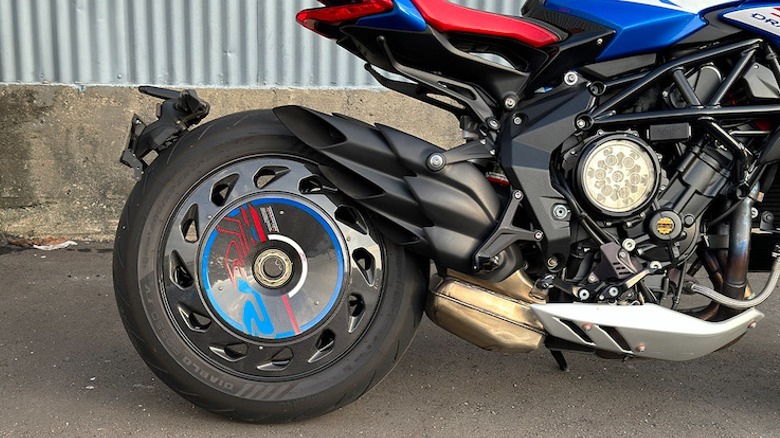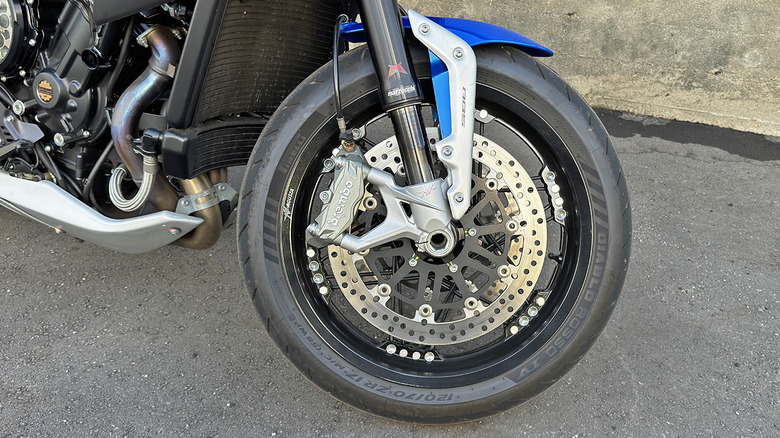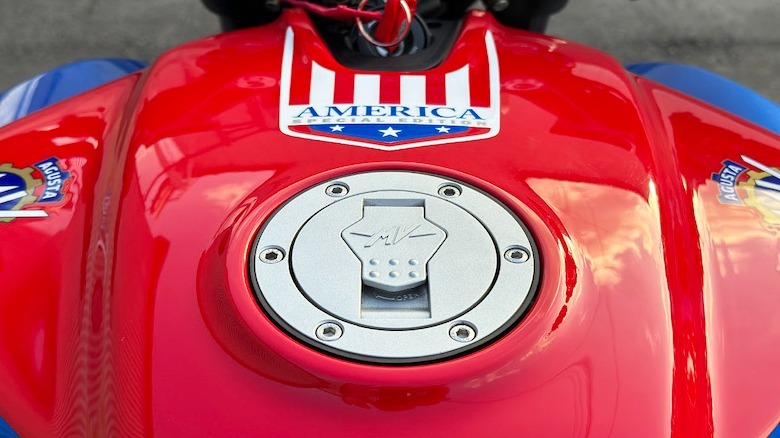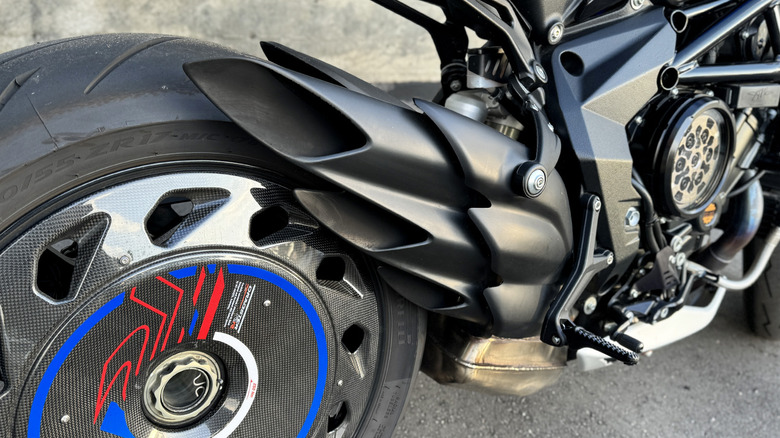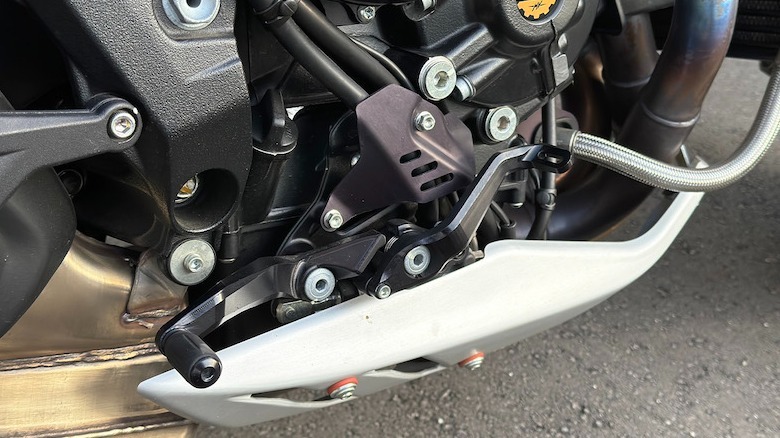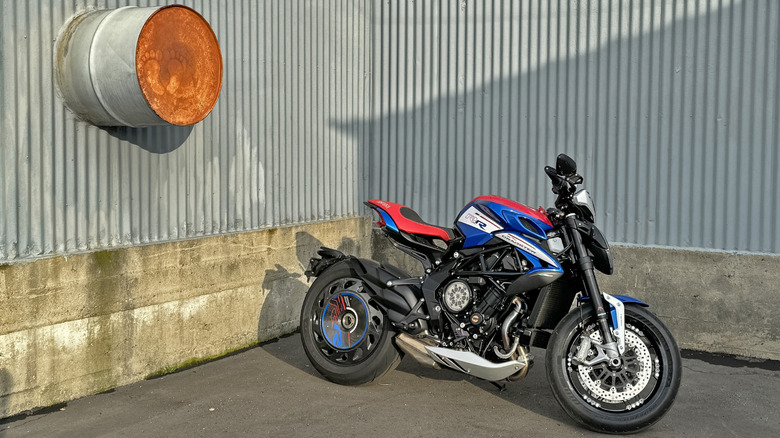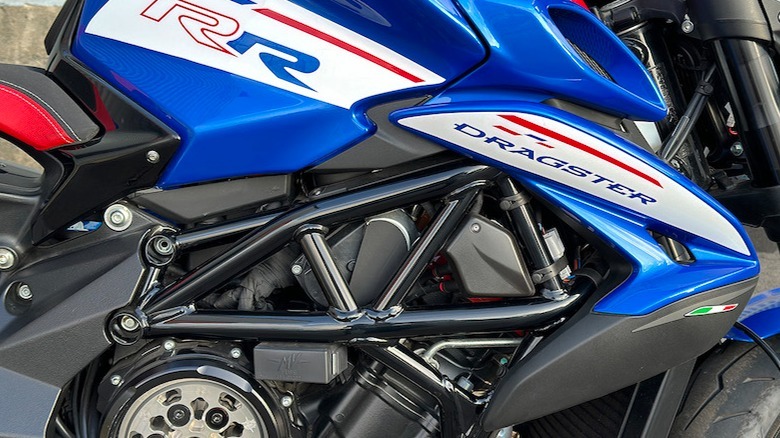MV Agusta Dragster RR America Review: Howling Speed & Trick Clutch Come At A Huge Price
- Insane three-cylinder engine revs with a hornet's shriek
- Innovative clutch system allows for automatic-style starts and stops
- Comfortable and upgright, yet still sporty and nimble
- Sweet red-white-and-blue graphics on the limited-edition
- Not quite as many features as the price might imply
- Strange metal plate brings discomfort during hard braking
- Other bikes at similar pricing deliver more power and goodies
After a nonstop parade of motorcycle loans for the past couple of years that included multiple Ducatis, I felt a sense of undeniable curiosity when I recently got the chance to experience a bike built by another legendary Italian company. Though MV Agusta's Superveloce 800 stands out, at least to me, as the most beautiful modern motorcycle on the market, MV offered me a special-edition Dragster RR America as something of an appetizer or amuse bouche, decked out in sweet red, white, and blue graphics.
The Dragster's trellis-frame naked design leans toward a more aggressive aesthetic than I typically prefer, but more important than my own feelings on sporty style, the RR American also comes equipped with MV's SCS technology. SCS stands for Smart Clutch System and promises the mechanical capability of an automatic transmission with sequential shifting, allowing a rider to stop and go without pulling in the clutch lever. Engine ECU tuning, meanwhile, keeps track of throttle input to allow the SCS to operate at its best.
Comprehending the SCS system
Before the Dragster arrived, I watched a couple of videos on YouTube to hopefully wrap my head around how, exactly, the SCS works. The engine's algorithms modulate torque delivery based on throttle position and also movement, while the mechanical expander disc within the clutch pack itself then controls the slip and grip of the whole system—all while adding a few grams of weight. In my head, the design looks similar to the Wavetrac automatic torque-biasing differential in my Porsche 914's gearbox, but I still wondered how the SCS would apply to motorcycling in the real world.
And I can admit, my first time out on the Dragster America definitely included plenty of glancing down at the clutch and shifter levers, as well as the RPM readout on the bike's digital display. I rolled forward a few times without giving gas at stoplights, waited far too long while revving the cold engine up far too high expecting a shift that never came, and, of course, pulled in the clutch lever unnecessarily a ton. I wanted to get going, but a purposeful period of training to acclimate to the SCS should have probably fit into my plan for the day.
Still, the SCS and I finally settled into a rhythm with the concept that riding the Dragster is essentially the opposite of a sequential transmission in automatic mode. Instead of pulling in the clutch just to start and stop, I needed to flick the quickshifter with my left foot to shift up and down, while consciously telling my left hand to forget about the rest. The quickshifter itself clearly prioritizes smooth action at all RPMs, rather than the snappiest shifts at high revs and full throttle, because MV probably assumes every rider will simply stop pulling in the clutch at lower RPMs, too.
A first ride on the semi-automatic Dragster RR America
Stop-and-go traffic on the Pacific Coast Highway between my apartment and my favorite Malibu canyons provided the perfect setting to fully adjust to the Dragster and SCS combo. And the whole time, that 798cc triple revved happily, sounding best at full whomp between 3-6,000 rpm and then revealing a whole new personality above 8,000 on the way to a ridiculous 13,000 rpm redline. Something akin to half a flat-six, the soundtrack somehow pushed all the right Porsche buttons in my soul. Adding one of MV's four optional exhaust systems or an aftermarket setup might transform that howl into a full-on shriek, to best match the Dragster America's style.
For commuting, as in that PCH traffic, the Dragster geometry splits the gap between an upright naked and a sport bike. My knees never felt tight and my wrists never started to get sore, even on longer rides. Overall, thanks possibly in part to the SCS and a light throttle pull, the bike feels lighter and more nimble than a 385 pound dry weight suggests on paper. Then we turned right up into the hills and I discovered that despite the Dragster name, which might suggest a penchant for straight-line speed only, this naked loves to lean.
Once into tightening corners, the inverted Marzocchi forks and Sachs rear damper keep the tires surprisingly planted, with a confident amount of firmness that only occasionally approached discomfort on the waviest portions of road. The nose never dives too far under hard braking, allowing for smooth and progressive tilt while entering corners and then a handy application of throttle input coming out. I ratcheted up the adjustable steering damper a bit, actually, just because the front tire seemed to love turning into my countersteering so much.
Quick work of canyons on an upright naked
A set of strange lumps on each side of the gas tank might contribute to the exotic nature that MV Agustas need to inhabit, but kept my outside knee in an odd place until I realized that I needed to put more weight than usual on the outside peg. Doing so then coaxed me into sliding further off the seat and leaning a bit further forward onto my downhill hand, which only upped the pace further.
Snapping off downshifts at high revs provided the perfect amount of engine braking to complement Brembo front discs, though if I reined in too hard, a completely baffling MV-branded lump of metal plate on the crotch end of the gas tank—exactly where MotoGP riders tape a thick piece of foam padding—then constantly crunched the old family jewels. Absolute misery, terrible and brutally inexplicable, the placement forced me to brake a bit more steadily rather than at the very last moment.
With a hint of familiarity starting to set in, I toggled through various ride modes on the 5.5-inch screen hoping to discover more grunt while keeping the traction control, ABS, and launch control settings steady. All of a sudden, in what seemed like it should be the ideal mode for blasting through canyons, the throttle got far too lurchy for the rough-ish conditions complicated by pebbles and sand strewn across the canyons by recent winter storms.
Throttle maps and individual ride mode controls
With hillsides creating blind corners, I wanted more smoothness coming into and out of leaning. The unbelievable power that this relatively small three-cylinder engine produces, at low and high revs alike, only made me want to try out that Superveloce more.
Only after half an hour or so did I realize that Sport mode for the ECU map evened out the touchiness, while keeping the rest of the setting the same—and I eventually came to the conclusion that being able to easily change up each setting individually, as opposed to relying on each manufacturer's own concept of sport or race or wet, actually works better. No more digging deep into menu items to set up an individual mode on the fly (even if I always kept Front Lift Control, aka wheelie control, constantly activated because this Dragster absolutely cranks through gears with ease).
Details of the Dragster carryover
Some of the bike's smaller details stood out, for better or worse. The mirrors definitely need help, riding wide enough that somebody had clearly clipped them repeatedly while lane-splitting—which then seemed to loosen up the mounts enough that even mild headwinds would fold them in. The carbon rear wheel cover looks nifty but in the end adds a bit of a gimmicky note to the otherwise hardcore style, since aero gains seem minimal. And a tail tidy for that rear wheel would undoubtedly help to coalesce the entire design better.
The exposed clutch, a real work of art, actually wears a cover rather than an open-air Ducati dry clutch. So no deafening chatter, which might help keep neighbors happy. And though the Dragsters gets cruise control, the gauge display only shows ambient temperature with no coolant readout. The engine seems to run a bit hot, according to my inner thighs, and I can physically tell the temperature of the air around me, so why not give me a water temp readout, guys?
Do I really need the SCS?
Riding home, my mind started to ponder the whole point of the SGS system. To an extent, not needing to use the clutch seems ideal for commuters in stop-and-go traffic or while lane-splitting here in California. Using launch control or popping wheelies both seem other applicable use cases, as well, but in reality, the bike's light clutch makes grip strength less of a concern than on other, more substantially weighted, sport bikes and nakeds I've ridden. Call me old fashioned, but just like on air-cooled Porsches, I prefer using the clutch to upshift and downshift, rarely using quickshifters even on bikes with the best on the market. Isn't that level of engagement what we want from our motorbikes?
Luckily, on the Dragster America, we can still use the clutch whenever we want. But after a few more rides, I started to notice some of the more nuanced behavior that the SCS creates. Mostly, at low speeds, the brake bite and modulation change as the engine ECU and expander disc engage and disengage. The sensation actually approaches something similar to a Porsche PDK when not being pushed to the limit. And during light acceleration, with the right (wrong) application of throttle and a weak toe muscle, the gearbox will frequently shift from first into neutral—despite the fact that I found it almost impossible to select neutral on purpose at a standstill.
Adapting to SCS more quickly than expected
The thing is, on any SCS-equipped MV Agusta, you never need to select neutral when stopped. This subtle fact did force MV to install a parking brake that prevents the bike from rolling away while parked and in gear, though. The parking brake works simply, just push down on a piece that sticks off the front of the brake lever, then pop the brake again to release. Maybe the expander plate could be revised to engage when the engine switches off. But I'm no engineer, and it seems that doing so might require changing up the fully mechanical nature of the clutch system.
I also started to notice the Dragster's effects on my brain. My left hand, so accustomed to constant clutch action after the last few years—I do forearm exercises at home, in fact—began to get lazy, so constantly left the turn signal on while riding the Dragster. And now the symptoms have started to spread as I ride other bikes currently in the garage, as well. But again, more acclimation might solve this problem. Or maybe not...
Use cases for the MV Agusta Dragster RR America
The whole concept of the SCS pushes the limits of traditional motorcycling, which these days often requires new riders to learn how to use a manual transmission since so many can't drive a stick-shift car, either. In that regard, an MV so equipped might attract more new riders, a goal that the entire industry always tries so hard to meet. But I can report unequivocally that the Dragster RR America is definitely not a beginner bike. Gnarly, hot to trot, raring to go, and just a terrifying swarm of angry hornets up past 11,000 rpm—undeniably awesome to ride, but undoubtedly a serious handful for beginner riders.
So in the end, the SCS adds only a bit of additional function to the Dragster's all-rounder persona, and the system might work more cohesively on a more traditional commuter or even an ADV bike. Meanwhile, though the America special edition looks sweet while celebrating 50 years since MV's first special edition destined for the United States—the 1973 750S, for those keeping track—for a bike pushing $30,000 or so, the feature list reads a bit scant otherwise. The forks and rear damper do not offer electronic adjustment. Those 320-millimeter front Brembos pair with Nissin brake and clutch fluid reservoirs. Heated grips, even in the semi-chilly West LA late-winter weather, would certainly be nice.
Competitors at the price point also step up to much more hardcore statistics, while cheaper bikes perform similarly but without the exotic panache or exclusivity. Think of the most direct comparison, the Ducati Streetfighter V4 or V4 SP, the Triumph Speed Triple 1200 RR, or even a serious sport bike like the Honda CBR1000RR-R Fireblade. Then again, I found myself eager to pull on my gear and head back up to the hills shortly after the next rainstorm rolled through. And fiddling with the Dragster America's SCS setup while leaning out over the light trellis frame and narrow handlebars definitely made me a faster rider in only a few brief sessions. How much is that worth, I wonder.
